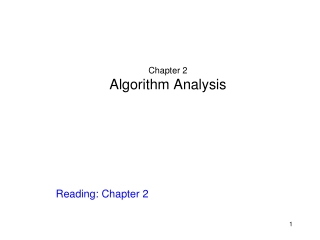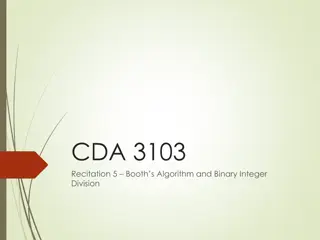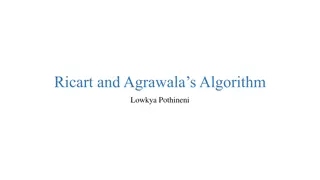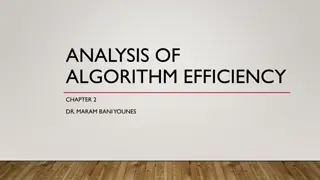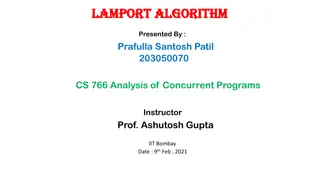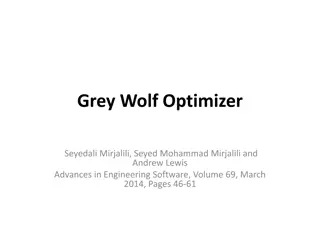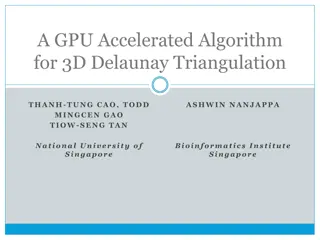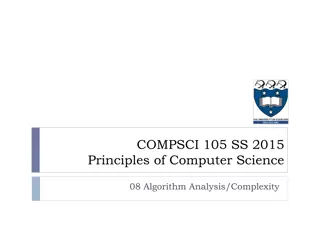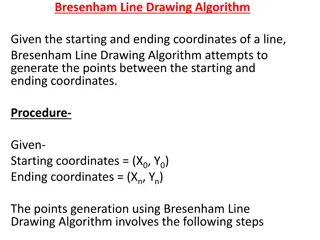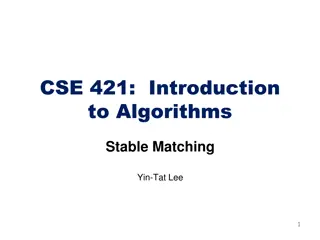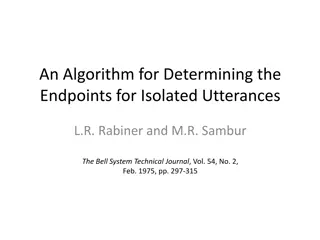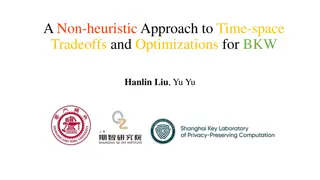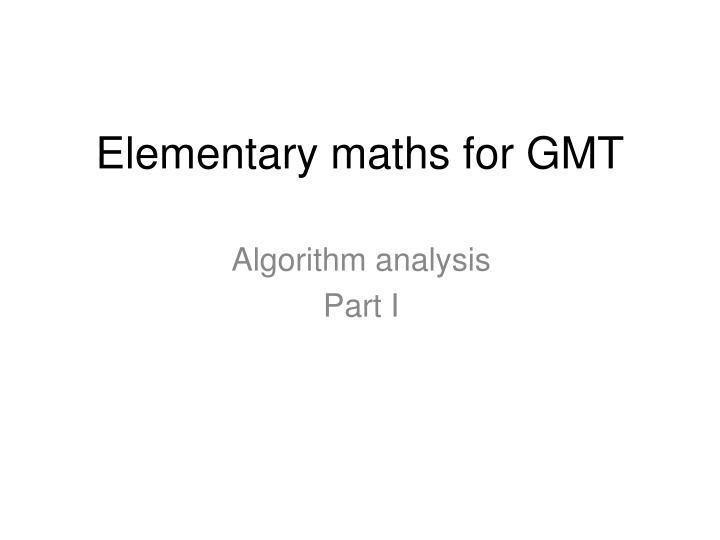
Algorithms for GMT Analysis
Delve into the world of algorithms with Elementary Maths for GMT Algorithm Analysis. Learn about the importance of running time, experimental studies, limitations, theoretical analysis, and pseudo-code in algorithm implementation. Explore different aspects such as input-output transformation, running time determination, and comparison methods. Gain insights into the theoretical and practical implications of algorithm design and analysis.
Download Presentation

Please find below an Image/Link to download the presentation.
The content on the website is provided AS IS for your information and personal use only. It may not be sold, licensed, or shared on other websites without obtaining consent from the author. If you encounter any issues during the download, it is possible that the publisher has removed the file from their server.
You are allowed to download the files provided on this website for personal or commercial use, subject to the condition that they are used lawfully. All files are the property of their respective owners.
The content on the website is provided AS IS for your information and personal use only. It may not be sold, licensed, or shared on other websites without obtaining consent from the author.
E N D
Presentation Transcript
Elementary maths for GMT Algorithm analysis Part I
Algorithms An algorithm is a step-by-step procedure for solving a problem in a finite amount of time Most algorithms transform input objects into output objects Input Algorithm Output 2 Elementary maths for GMT Algorithm analysis
Running time The running time of an algorithm typically grows with the input size Average case time is often difficult to determine mathematically To define the running time, we focus on the worst case scenario Easier to determine Crucial and relevant to applications such as games, finance, robotics etc. best case average case worst case 120 100 Running Time 80 60 40 20 0 1000 2000 Input Size 3000 4000 3 Elementary maths for GMT Algorithm analysis
Experimental studies Write a program implementing your algorithm Run the program with inputs of varying size and composition Use function like clock()to get an accurate measure of the actual running time Plot the results 4 Elementary maths for GMT Algorithm analysis
Limitations of experiments It is necessary to implement the algorithm, which may be difficult Results may not be indicative of the running time on other inputs not included in the experiments In order to compare two algorithms, the same hardware and software environments must be used 5 Elementary maths for GMT Algorithm analysis
Theoretical analysis Uses a high-level description of the algorithm instead of an implementation Characterizes running time as a function of the input size, denoted n Takes into account all possible inputs Allows us to evaluate the cost of an algorithm independently from the hardware/software environment 6 Elementary maths for GMT Algorithm analysis
Pseudo-code High-level description of an algorithm More structured than English prose Less detailed than a program Preferred notation for describing algorithms Hides program design / implementation / syntax issues 7 Elementary maths for GMT Algorithm analysis
Pseudo-code example How to compute the max value in an array of integers AlgorithmarrayMax (A, n) Input array A of n integers Output maximum element of A currentMax A [0] fori 1 ton 1 do ifA[i] currentMaxthen currentMax A[i] returncurrentMax 8 Elementary maths for GMT Algorithm analysis
Pseudo-code details Control flow if ... then ... [ else ... ] while ... do ... repeat ... until ... for ... do ... Indentation replaces braces Method declaration Algorithm method ( arg [, arg ...] ) Input ... Output ... Method call var.method (arg [, arg...]) Return value return expression Expressions assignment (like = in Java/C#/C++) = Equality testing (like == in Java/C#/C++) Superscripts (e.g. n2) and other mathematical formatting allowed 9 Elementary maths for GMT Algorithm analysis
Random Access Machine (RAM) A CPU that executes the pseudo-code A potential unbounded bank of memory cells, each of which can hold an arbitrary number or character Memory cells are numbered and accessing any cell in memory takes unit time 012 10 Elementary maths for GMT Algorithm analysis
Important functions Eight functions often appear in algorithm analysis Constant 1 Logarithmic log n Linear n N-Log-N n log n Quadratic n2 Cubic n3 Exponential 2n Factorial n! 11 Elementary maths for GMT Algorithm analysis
Important functions Eight functions often appear in algorithm analysis Constant 1 Logarithmic log n Linear n N-Log-N n log n Quadratic n2 Cubic n3 Exponential 2n Factorial n! 12 Elementary maths for GMT Algorithm analysis
Important functions Eight functions often appear in algorithm analysis Constant 1 Logarithmic log n Linear n N-Log-N n log n Quadratic n2 Cubic n3 Exponential 2n Factorial n! 13 Elementary maths for GMT Algorithm analysis
Important functions Constant 14 Elementary maths for GMT Algorithm analysis
Necessary math Summations Logarithms and exponentials Properties of logarithms ?log ?? =?log? +?log? ?log ?/? =?log? ?log? ?log??= ? ?log? ?log? =?log? / ?log? Properties of exponentials ?(?+?)= ???? ???= ??? ?? / ??= ?(? ?) ? = ? ??= ?? ?log ? ?log ? 15 Elementary maths for GMT Algorithm analysis
Primitive operations Basic computations performed by an algorithm Identifiable in pseudo-code Largely independent from the programming language Exact definition not important (we will see why later) Assumed to take a constant amount of time in the RAM model Examples Evaluating an expression Assigning a value to a variable Indexing into an array Calling a method Returning from a method 16 Elementary maths for GMT Algorithm analysis
Counting primitive operations By inspecting the pseudo-code, we can determine the maximum number of primitive operations executed by an algorithm, as a function of the input size AlgorithmarrayMax(A, n) currentMax A[0] fori 1 ton 1 do ifA[i] currentMaxthen currentMax A[i] { increment counter i } returncurrentMax # operations 2 2n 2(n 1) 2(n 1) 2(n 1) 1 Total: 8n 3 17 Elementary maths for GMT Algorithm analysis
Estimating running time The algorithm arrayMax executes 8? 3 primitive operations in the worst case If we define a as the time for the fastest primitive operation b as the time for the slowest primitive operation T(n) as the worst-case time of arrayMax Then, ?(8? 3) ?(?) ?(8? 3) Hence, the running time T(n) is bounded by two linear functions 18 Elementary maths for GMT Algorithm analysis
Growth rate of running time Changing the hardware / software environment affects T(n) by a constant factor, but does not alter the growth rate of T(n) The linear growth rate of the running time T(n) is an intrinsic property of the algorithm arrayMax 19 Elementary maths for GMT Algorithm analysis
Constant factors The growth rate is not affected by constant factors lower-order terms Examples 10? + 10 is a linear function what if we replace + 10 by + 102 ? 10?2+ 10 is a quadratic function what if we replace + 10 by + 102 ? what if we replace + 10 by +10n ? 20 Elementary maths for GMT Algorithm analysis
The Big-Oh Given functions ?(?) and ?(?), we say that ?(?) is ?(? ? ) if there is a positive constant ? and an integer constant ?0 1 such that ?(?) ??(?) for all ? ?0 Example: 2? + 10 is ?(?) 2? + 10 ? ? ? 2 ? 10 ? 10 / (? 2) Pick c = 3 and n0 = 10 (or c = 12 and n0 = 1 , ...) 21 Elementary maths for GMT Algorithm analysis
The Big-Oh Example: the function n2 is not ?(?) ?2 ? ? ? ? The above inequality cannot be satisfied since c must be a constant 22 Elementary maths for GMT Algorithm analysis
More Big-Oh examples 7? 2 is ?(?) We need ? > 0 and ?0 1 such that 7? 2 ? ? for ? ?0 This is true for ? = 7 and ?0= 1 3?3+ 20?2+ 5 is ?(?3) We need ? > 0 and ?0 1 such that 3?3+ 20?2+ 5 ? ?3 for ? ?0 This is true for ? = 4 and ?0= 21 3log? + 5 is ?(log?) We need ? > 0 and ?0 1 such that 3log? + 5 ? log? for ? ?0 This is true for ? = 8 and ?0= 10 23 Elementary maths for GMT Algorithm analysis
Big-Oh and growth rate The Big-Oh notation gives an upper bound on the growth rate of a function The statement ?(?) is ?(? ? ) means that the growth rate of ?(?) is no more than the growth rate of ?(?) We can use the Big-Oh notation to rank functions according to their growth rate ?(?) is ?(? ? ) ?(?) is ?(? ? ) g(?) grows more YES NO ?(?) grows more NO YES same growth YES YES 24 Elementary maths for GMT Algorithm analysis
Big-Oh rules If ?(?) is a polynomial of degree d, then ?(?) is ?(??), so: Drop the lower-order terms Drop the constant factors Use the smallest possible class of functions We say that 2? is ?(?) instead of 2? is ?(?2) Use the simplest expression of the class We say that 3? + 5 is ?(?) instead of 3? + 5 is ?(3?) 25 Elementary maths for GMT Algorithm analysis
Asymptotic algorithm analysis The asymptotic analysis of an algorithm determines the running time in Big-Oh notation To perform the asymptotic analysis We find the worst case number of primitive operations executed as a function of the input size We express this function with Big-Oh notation Example We determine that algorithm arrayMax executes at most 8? 3 primitive operations We say that algorithm arrayMax runs in ?(?) time Since constant factors and lower-order terms are eventually dropped anyhow, we can disregard them when counting primitives operations 26 Elementary maths for GMT Algorithm analysis
Computing prefix averages We further illustrate asymptotic analysis with two algorithms for prefix averages The i-th prefix average of an array X is the average of the first (i+1) elements of X: ? ? =? 0 + ? 1 + + ? ? 35 X A 30 25 20 15 10 ? + 1 Computing the array A of prefix averages of another array X has applications to financial analysis 5 0 1 2 3 4 5 6 7 27 Elementary maths for GMT Algorithm analysis
Prefix averages Quadratic example The following algorithm computes prefix averages in quadratic time by applying the definition AlgorithmprefixAveragesQuad(X, n) Input array X of n integers Output array A of prefix averages of X A new array of n integers fori 0 ton 1 do s X [0] forj 1 toido s s+X [j] A [i] s (i+ 1) return A # operations (after drop) n n n 1 + 2 + + (n 1) 1 + 2 + + (n 1) n 1 28 Elementary maths for GMT Algorithm analysis
Prefix averages Quadratic example Arithmetic progression The running time of prefixAveragesQuadis 7 ?(1 + 2 + + ?) 6 5 The sum of the first ? integers is 4 ? ? + 1 /2 3 There is a simple visual proof of this fact 2 1 0 Thus, the algorithm prefixAveragesQuad runs in ?(?2) time recall that lower-order terms can be disregarded (n / 2) 1 2 3 4 5 6 29 Elementary maths for GMT Algorithm analysis
Prefix averages Linear example The following algorithm computes prefix averages in a linear time by keeping a running sum AlgorithmprefixAveragesLinear(X, n) Input array X of n integers Output array A of prefix averages of X # operations (after drop) A new array of n integers s 0 fori 0 ton 1 do s s+X [i] A [i] s (i+ 1) returnA n 1 n n n 1 Algorithm prefixAveragesLinearruns in ? ? time 30 Elementary maths for GMT Algorithm analysis
Relatives of Big-Oh Big-Omega ?(?) is ?(? ? ) if there is a constant ? > 0 and an integer constant ?0 1 such that ? ? ? ?(?) for ? ?0 Big-Theta ?(?) is (? ? ) if there are constants ? > 0 and ? > 0 and an integer constant ?0 1 such that ? ? ? ? ? ? ?(?) for ? ?0 31 Elementary maths for GMT Algorithm analysis
Intuition for asymptotic notation Big-Oh ? ? is ?(? ? ) if ?(?) is asymptotically less than or equal to ?(?) Big-Omega ? ? is ?(? ? ) if ?(?) is asymptotically greater than or equal to ?(?) Big-Theta ? ? is (? ? ) if ?(?) is asymptotically equal to ?(?) In Big-Omega and Big-Theta notation we also omit constants and lower-order terms 32 Elementary maths for GMT Algorithm analysis
Examples of relatives of Big-Oh 5?2 is ?(?2) ?(?) is ?(? ? ) if there is a constant ? > 0 and an integer constant ?0 1 such that ? ? ? ?(?) for ? ?0 True for ? = 5 and ?0= 1 5?2 is ?(?) ?(?) is ?(? ? ) if there is a constant ? > 0 and an integer constant ?0 1 such that ? ? ? ?(?) for ? ?0 True for ? = 1 and ?0= 1 5?2 is (?2) ?(?) is (? ? ) if it is ?(?2) and ?(?2). We have already seen the former, for the latter recall that ?(?) is ?(? ? ) if there is a constant ? > 0 and an integer constant ?0 1 such that ? ? ? ?(?) for ? ?0 True for ? = 5 and ?0= 1 33 Elementary maths for GMT Algorithm analysis

